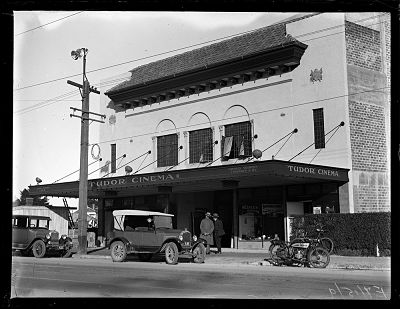“Seen at the Tudor” reads the title of a weekly column that appeared in the newspaper Remuera Round between 1945 and 1947.
Each of these articles lists the names of some of those present at the Tudor on the previous Saturday evening. Though generally known as the Tudor Theatre, the Tudor was Remuera’s local cinema. But it was more than a cinema. For many years it was a centre of social life in Remuera.
The building of the Tudor Theatre at 333 Remuera Road, where the Tudor Mall now stands was completed in 1926. In contrast to the smaller cinemas of today it was large, seating an audience of 1066.
Like many cinemas of the time it was designed to exude an aura of fantasy. As the name implies the interior was in a Tudor style. You entered through a foyer lined with panels of dark wood each one bearing a carved emblem. Either side of the foyer twin staircases led up to the lounge and the ‘best seats’ in the circle.
The lounge was reminiscent of the sitting room of a gracious home, with dark paneling, comfortable armchairs, and a fireplace. Tudor Rose emblems and a coat of arms adorned the wall above the mantelpiece. An unusual feature of the lounge was a circular opening with a wooden surround and upholstered seating. From here you could look down to the foyer below.
As a business the Tudor had shaky beginnings. In the financially troubled years of the late 1920’s the theatre changed hands several times. By 1930 the well-known Fuller Hayward Theatres Corporation managed the cinema. Henry Hayward often called ‘the father of the New Zealand motion picture industry’ was President and Managing Director of Fullers Hayward. His son Phil was an executive in the firm.1
Because of financial difficulties Fullers Hayward decided to close the Tudor. On a Saturday night in 1930 they showed their last film. But Phil Hayward stepped in and raised the required 280 pounds to take over. On the Monday evening films were shows as usual.*
Once Phil Hayward took over the shaky days ended and the Hayward family ran the Tudor continuously from then on. During World War II when finding staff was difficult Phil Hayward and his daughter Jill ran the cinema. When Phil’s son Selwyn returned from World War II he entered the family business and in 1948 on the death of his father took over the management.
There was a big change at the Tudor in its early years. The first films shown were silent with a live piano accompaniment but during the 1930’s sound equipment was installed. Audiences could now enjoy ‘the talkies’ and the musicals that soon became popular.
For a time, during the 1930’s, the Tudor was both cinema and dance hall. After the evening film session was over the area between the stalls and the stage became a dance floor, known as Moulin Rouge this enterprise was run by a Mr. Speedy.
The 1940’s and 1950’s were golden years for cinemas. ‘Going to the pictures’ was a regular occasion for many. By the early 1950’s Auckland had 65 city and suburban cinemas. ii The New Zealand film history, Celluloid Dreams notes that “During 1945-46 on average, every person in the country went to the movies 22 times a year, a rate exceeded only by the America’s.”iii
Selwyn Hayward, who booked and hired the films for the Tudor aimed for quality. After the city cinemas the Tudor had first call on MGM releases. MGM were known for their slick, polished productions. The Alfred Hitchcock thriller Spellbound and the dramatic features, Indiscretion starring Barbara Stanwyck and The Dark Mirror with Olivia de Havilland were among those films shown during the 1940’s. Later the comedy The Secret Life of Walter Mitty with the zany Danny Kaye was a hit with audiences. *
Henry Hayward and his son Phil formed Auckland Cinemas Ltd., which subsequently managed the Tudor together with a chain of Auckland suburban cinemas. Especially popular movies were shown for longer than the usual three nights or were brought back for re-runs. Selwyn Hayward recalls the teasing he received from patrons about the number of times he showed The Great Waltz.

